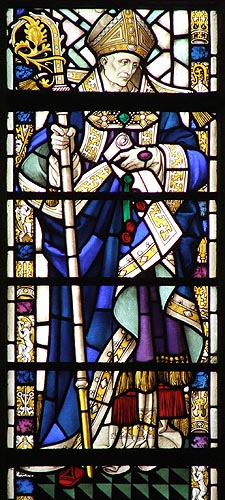
EBK Home
Kingdoms
Royalty
Saints
Pedigrees
Archaeology
King Arthur
Mail David
 Leofric,
Bishop of Exeter
Leofric,
Bishop of Exeter(1016-1072)
Leofric was the mid-11th century successor of Bishop Lyfing to the Sees of Crediton and St. Germans (Cornwall). The Sees remained united, but Leofric was a bishop of very different character to his predecessor. The "king's priest" and the "king's high-chancellor," he seems to have reflected the earnest piety of the Royal Confessor, under whom he was appointed. A document inserted in a volume of the Gospels, now in the Bodleian Library in Oxford, but which was originally Leofric's own donation to the monastery of St. Peter at Exeter (the Cathedral), describes him as a man "of modest life and conversation who, when he succeeded to his see, went about his diocese studiously preaching the Word of God to the people committed to him and instructing the clergy in learning." It is added that he built churches, not a few, and vigorously administered the other duties of his office.
The assertion of John of Worcester, that Leofric was a Briton (Brytonicus - a native Celtic Devonian), is rendered doubtful by his name, though he may have been born in the West Country of Saxon parents. William of
Malmesbury tells us that his early years were spent in training in Lotharingia on the Continent, presumably at a reformed house of secular canons. He met the future
King Edward the Confessor in Bruges in 1039 and, two years later, accompanied him to England. Here, he served as a scribe in the Royal Court before his elevation to be Bishop of Devon & Cornwall in 1047.
In 1050, Bishop Leofric, removed the Episcopal seat for the united Sees of Devon and Cornwall from Crediton to Exeter. After the Norman Conquest, the seats of many of the Saxon bishoprics which had been established in the open country, such as Sherborne,
Dorchester and Crediton, were transferred to safer positions within the walls of the chief towns. The necessity for this change, however, had already become evident in the days of the Confessor. Devon and Cornwall had been frequently overrun by the Northmen, who had not spared the religious houses, and who, whilst wintering at Exeter, as they had done more than once, must have readily found their way to Crediton via the river or along the ancient hill road. The Bishop's flocks and herds and the treasures of his church must have been frequently swept away and, accordingly, "the barbarous attacks of pirates" are stated as the especial reason which induced Bishop Leofric to apply for the permission of King and Pope to remove his see from the "vill" of Crediton to the city of Exeter.
A monastery had been founded in Exeter by King Athelstan, around AD 928, and dedicated to St. Mary & St. Peter. This monastery, with its possessions, was now (1050) solemnly assigned to Bishop Leofric, as the chief place of his see, and its conventual church became his cathedral. He was installed in the episcopal chair by the Confessor himself, who "supported his right arm, and Queen Edith his left." The ceremony took place in presence of the two archbishops and of many other bishops and nobles.
Although there was somewhat more security within the walls of Exeter than at Crediton, the monastery of St. Peter had been greatly despoiled by the Northmen. Only two hydes of land, at Ide, remained in its possession and upon these were only seven head of cattle. The monastery itself was not much better furnished. Half-a-dozen books of little value, and "one worthless priest's dress" were all the library and wardrobe that, according to his own statement, Bishop Leofric found in it when he took possession. His will enumerates the estates which he recovered for the minster, the vestments, articles of church furniture and sacred vessels which he bestowed on it, besides some fifty-five books, both in English and Latin, as many as seventeen of which still survive. One, the "great English book with everything wrought poetry-wise," remains famous among the treasures of the cathedral. It is probable that but a small number of monks remained in the convent at the time of Leofric's accession. They are said to have been removed by the Confessor to the Abbey of Westminster, which he was then in the course of establishing. Leofric replaced them, at Exeter, with a body of prebendaries, or regular canons, who, says Malmesbury, "not according to English custom, but rather following that of Lotharingia" lived together, eating at a common table and sleeping in a common dormitory.
Leofric was not displaced at the period of the Conquest, and was no doubt within the walls of Exeter during the siege of the city by the Norman King in 1068. He may have assisted in inducing the citizens to submit to the Conqueror. At all events, he continued undisturbed in his bishopric until his death on 10th February 1072. He was buried in the crypt of his cathedral and two memorials for him were erected, at later periods, in the present church, where they still remain.
Edited from Richard John King's "Handbook to the Cathedrals of England: Southern Division" (1903).
